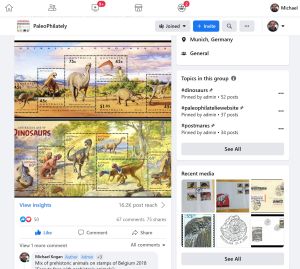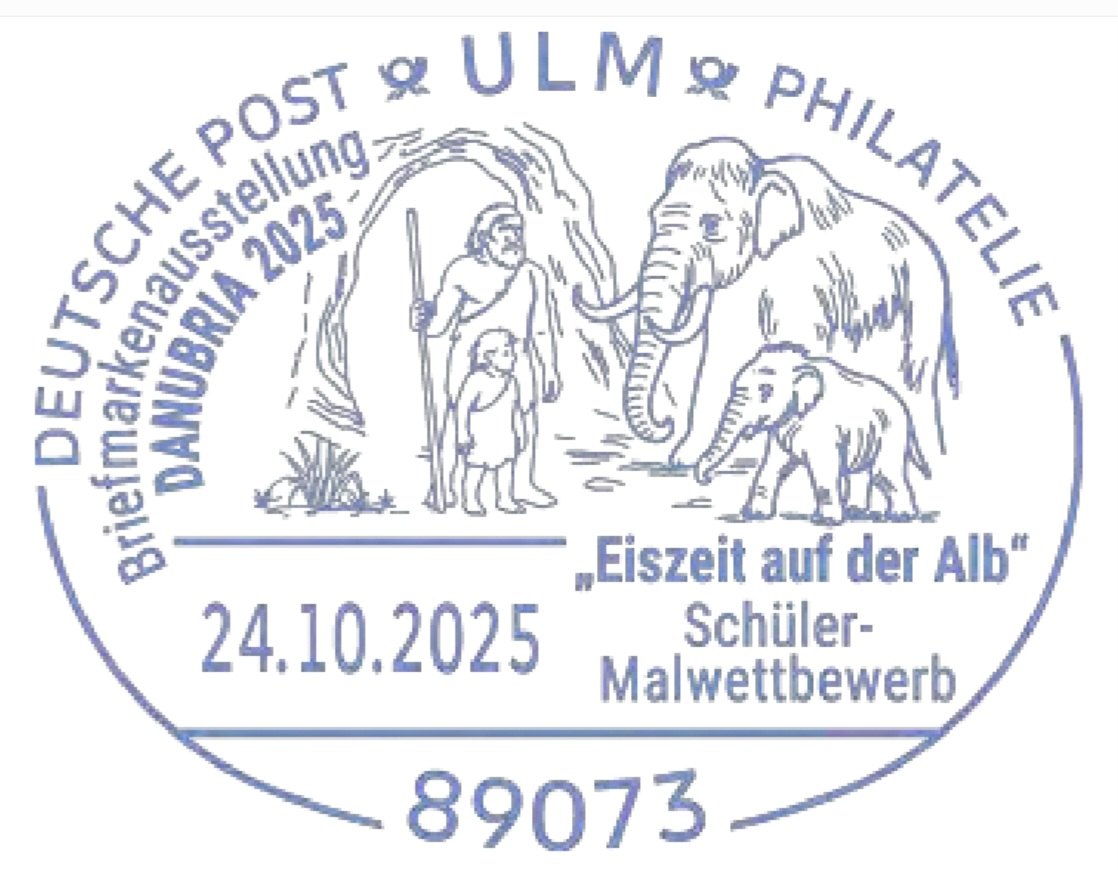Dinosaurs and other prehistoric animals, fossils,
fossil-found places, paleontologists and contributors to Paleontology
and Paleoanthropology as well as Natural History Museums on
stamps, postmarks and postal stationeries issued in 2025
If you know about any other Philatelic item related to Paleontology or Paleoanthropology, issued this year which is not mentioned below, please inform me.
|

|
Do you have any questions or want to talk about your hobby
with collectors who share the same interest? Looking for swap partners ? Join more than 2000 members of the "PaleoPhilately" group on Facebook |

|
| 1840-1949 | 2025, 2024, 2023, 2022, 2021, 2020, 2019, 2018, 2017, 2016, 2015, 2014, 2013, 2012, 2011, 2010, 2009, 2008, 2007, 2006, 2005, 2004, 2003, 2002, 2001, 2000, 1999, 1998, 1997, 1996, 1995, 1994, 1993, 1992, 1991, 1990, 1989, 1988, 1987, 1986, 1985, 1984, 1983, 1982, 1981, 1980, 1979, 1978, 1977, 1976, 1975, 1970-1974, 1960-1969, 1950-1959, 1840-1949 |
This month:
Later this year:
|

Woolly Mammoth on commemorative postmark of Germany 2025 |
Some Books about Dinosaurs and other prehistoric animals, coming soon or issued recently

|

|

|

|

|
|
"Elephants and Their Fossil Relatives: A 60 Million Year Journey" Coming in 2026. Amazon: USA, UK, DE. |
"The Secret Lives of Dinosaurs: Unearthing the Real Behaviors of Prehistoric Animals" Coming soon! Amazon: USA, UK, DE. |
"Spinosaur Tales: The Biology and Ecology of the Spinosaurs" Coming soon! Amazon: USA, UK, DE. |
"BBC Walking With Dinosaurs: Uncovering the Secret Stories of Prehistoric Life, Book". Published in 2025 Amazon: USA, UK (Blu-ray), DE. |
"Dinosaurs new vision of a lost world". Published in 2025 Amazon: USA, UK, DE. |
Official stamps directly related to Paleontology: dinosaurs and other prehistoric animals, fossils, paleontologists
| 30.09.2025 - Poland | ||
 |
|
|
| 04.07.2025 - Gibraltar [1] | 30.06.2025 - Malaysia | 09.05.2025 - Portugal [O2] |
 |
 |
 |
| 08.05.2025 - Gibraltar [1] | 05.05.2025 - Jersey [1] | 11.02.2025 - San Marino |
 |
 |
 |
Notes:
[1]
 |
|
| The banner of "The 2025 EUROPA stamps competition". Image credit: the home page of EUROPA stamps (accessed on May 9th, 2025) | |
 |
 |
| The Norway's EUROPA 2025 stamp. | The French EUROPA 2025 stamp. |
EUROPA stamps underlines cooperation in the posts domain, taking into account promotion of philately. They also build awareness of the common roots, culture and history of Europe and its common goals. As such, EUROPA stamp issues are among the most collected and most popular stamps in the world. Since the first issue in 1956, EUROPA stamps have been a tangible symbol of Europe’s desire for closer integration and cooperation.
The theme of the year 2025, chosen by PostEurop, is devoted to "National Archaeological Discoveries".
Some of these stamps show tools or art objects from the "Ice Age" (Germany), fossils of Neanderthal (Gibraltar) and the "Ice Age" megafauna (Jersey - mammoth skull).
One of the EUROPA stamps of Norway shows a skeleton of a dog (not a fossil) with a collar from the 16th century, found at Lendbreen Pass in Jotunheimen.
In March 2025, the Post Authority of France announced the issue of their EUROPA stamp, featuring a sauropod dinosaur. In the following month, the sauropod stamp was replaced, as inappropriate to the Archaeological Discoveries topic. Although 720,000 copies have already been printed, they were not be released. A new design, showing a recent archaeological discovery (wine jug made in Greece), was issued instead.

[2] The stamp in the Souvenir-Sheet shows the famous Lapedo child from "Lagar Velho 1" excavation site. It is believed to be a hybrid that had a Neanderthal parent and an anatomically modern human parent (Homo sapiens). The bones of the skeleton present a mosaic of European early modern human and Neanderthal features. This morphological mosaic suggests interbreeding between late archaic and early modern humans in Iberia, challenging the idea of a complete replacement of Neanderthals by early modern humans. It highlights the complex cultural and biological processes that contributed to the emergence of modern humans. [R2]
Some personalized stamps related to Paleontology: dinosaurs
| 05.02.2025 - Austria [SP1] | ||
 |
|
|
Notes:
[SP1] The Mini-Sheet of 8 personalized stamps and a tab in the middle was offered by philatelic bureau of Austria at price of Euro 11.00 for subscribes or Euro 12.99 for others, while the value of these stamps is Euro 8.60. Neither technical nor background information were provided.
Some stamps to consider: prehistoric animals as art objects (cave paintings)
| 09.05.2025 - Monaco [1] [O2] | 08.05.2025 - Germany | 27.03.2025 - Spain [O1] |
 |
 |
 |
Notes:
[O1] National Museum and Research Center of Altamira is a center dedicated to the conservation of, research into, and the sharing of information about the cave of Altamira in Santillana del Mar (Cantabria), Spain, named a World Heritage Site by Unesco. The museum offers prehistoric technology workshops to visitors, as well as a permanent exhibition called Times of Altamira, which contains objects from Altamira as well as those from other palaeolithic caves of Cantabria. [R1]
[O2] The skull in the middle of the bottom side of the stamp is a lynx skull, not a skull of a prehistoric animal.
Commemorative Postmarks directly related to Paleontology and Paleoanthropology: dinosaurs and other prehistoric animals, fossils, human ancestors, paleontologists
Legend is here| 30.09.2025 - Poland [FDC] | 04.07.2025 - Gibraltar [FDC] | |
 |
 |
|
| 18.06.2025 - China [Sp] | ||
 |
 |
 |
| 08.05.2025 - Gibraltar [FDC] | 12.02.2025 - India [Sp] [PM1] | 11.02.2025 - San Marino [FDC] |
 |
 |
 |
Notes:
[PM1] The National Marine Gondwana Fossils Park is located about 2 km from the district headquarters in Manendragarh, Chhattisgarh, along the Hasdeo River. Fossils of ancient marine life can still be seen in the area. Around 28 million years ago, a glacier covered the region, later retreating to form a strip called "Tathis", through which marine animals entered the present Hasdeo River. These creatures gradually became extinct, but their fossils remain. Discovered in 1954 by S.K. Ghosh, the site was later confirmed by scientists from the Birbal Sahni Institute of Paleo Sciences in 2015. The park offers a rare glimpse into ancient marine ecosystems from the Gondwana period. [R3]
Some postmarks to consider: prehistoric animals as art objects (Ice Age figures, cave paintings), flit tools
Legend is here| 09.05.2025 - Monaco [FDC] | ||
 |
|
|
| 08.05.2025 - Germany [FDC] | 27.03.2025 - Spain [FDC] | |
 |
 |
 |
References:

|
- [R1] National Museum and Research Center of Altamira: Wikipedia,
- [R2] Lapedo child: Wikipedia,
- [R3] Postmark of India: the reverse side of commemorative cover.
| 1840-1949 | index | 2024>> |